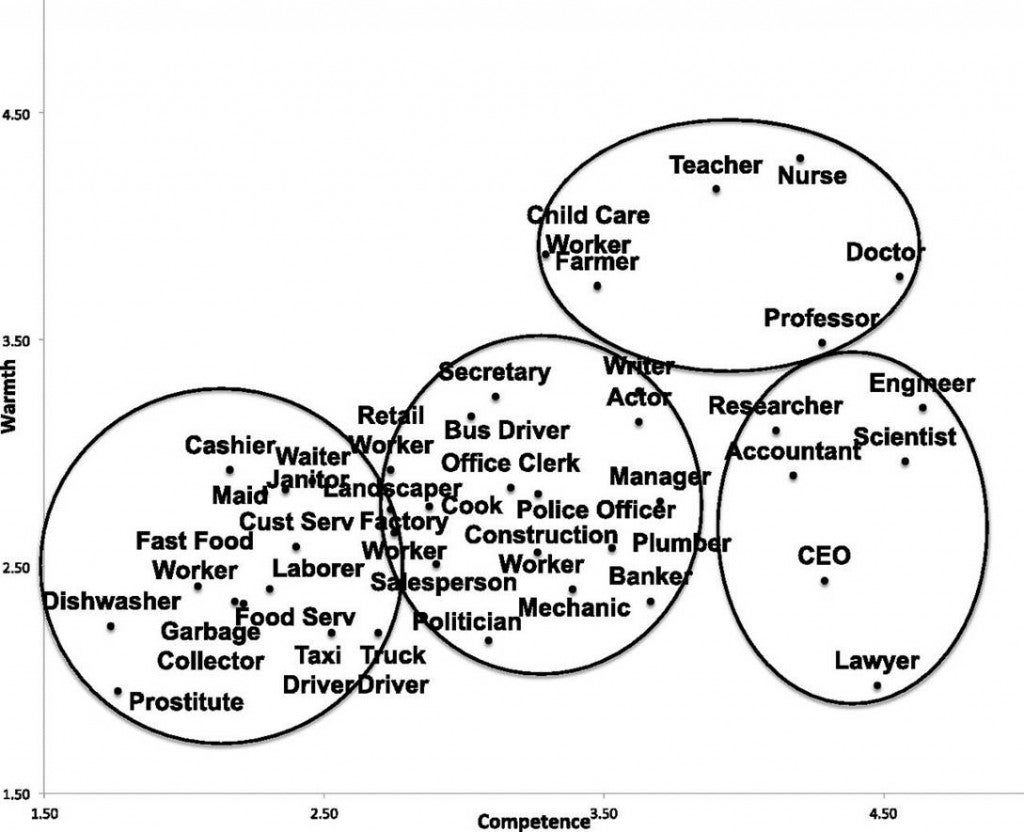A couple of years ago a science communication paper came out suggesting public trust differs depending upon the perceived warmth and competence of different professional groups.
As can be seen in the graphic below from that paper by Susan T. Fiske and Cydney Dupree (PNAS 2014;111:13593-13597) that was good news for nurses and teachers, and not such great news for lawyers who are seen as competent but not trustworthy. But lawyers are not typically trying to communicate science and so perhaps this lack of trust is not a deal breaker for them.

Warmth–competence ratings of commonly mentioned jobs.
Scientists fared less well than professors, although I am not 100% sure what the difference is between a scientist and a professor. I assume that professors are seen to be those teaching at universities, whereas scientists might include those presumably nefarious industry scientists.
But for scientists interested in scientific communication the take home message of the paper was to attempt to be “warmer”, and show concern for humanity and the environment. As someone who entered agricultural science because of my interest in how genetics can be used to simultaneously increase food production and minimize the environmental footprint of agriculture, those concerns for humanity and the environment are actually the cornerstone of my profession.
However it was another finding of the study that has been rattling around in the back of my brain.
And that finding was that in particular, “Americans seem wary of researchers seeking grant funding”. Think about that. As a public sector scientist who mentors several graduate students in my laboratory, I would perhaps be more wary of scientists who were not seeking grant funding because how else can you pay for research supplies and expenses? That made me think there is a fundamental disconnect between how science is actually funded, and the public perception of how science is funded.
In my own case, I receive a salary from the University of California, an office on the Davis camps, and the holy grail of space, a wet laboratory. The rest of it is up to me. If I want to do research, I have to “seek grant funding”. And as a molecular geneticist working with large animals who need feed and care, this is expensive research.
Perhaps one of the biggest expenses, and undoubtedly the most satisfying part of research, is funding those pesky graduate students who actually do the work. And they do not come cheap. I looked at a recent USDA grant I was awarded and the approximate annual cost of a graduate student is in the ball park of $40K a year in direct costs for fees and living stipend. Apparently students need both an apartment to live in and food to eat.
And with University overhead, which for this grant was 30% of total costs, this brings the annual cost up to around $52,000 a year – so for a 2 years Masters student I have to seek grant funding for $100,000. That is about the approximate cost of new Maserati. And funds for a PhD, which is typically 5 years, is a whopping quarter of a million dollars! And that does not actually pay for any experimental reagents or animal care fees, just brains and boots on the ground.
Therefore if we want graduate students to be trained at public universities their professors need to seek grant funding. I have been fortunate to obtain public funding for my research program, all of which can be freely accessed at my university webpage.
Public research funding programs are highly competitive. In 2014, the last year for which I could find data , at the USDA National Institute of Food and Agriculture’s flagship competitive grants program, the Agriculture and Food Research Initiative (AFRI), “the success rate in FY 2014, calculated in terms of number of proposals funded (excluding conferences, supplements, continuing increments of the same grant, and NIFA Fellowships) divided by the number of proposals submitted for review, was 11 percent”. That roughly means that for every 100 proposals submitted, 11 got funded.
Imagine spending 90% of your time putting words to paper that no else will read, with the exception of a single grant review panel. Or writing a paper that only has a 1 in 10 chance of being accepted by a peer-reviewed journal. And yet scientists seeking public research funding spend a lot of their time writing grants that never are funded.
Things are a little better for medical research. in 2014 the National Institutes of Health (NIH) received 51,073 research project grant (RPG) applications, out of which they funded 9,241, resulting in a success rate of 18.1 percent.
So make whatever judgment you may about the trustworthiness and perceived warmth of scientists and professors. But please understand that researchers seeking grant funding, especially public grant funding, is not a reason to be suspicious. It is actually a sign of an active scientist who is likely trying to fund graduate students, reagents and experimental supplies to enable them to undertake research in their chosen field of interest.
If the public is wary and untrusting of scientists who seek research funding, we have a real scientific communication problem. Those are most likely public sector scientists trying to secure funding to enable them to support, mentor and train the next generation of scientists.